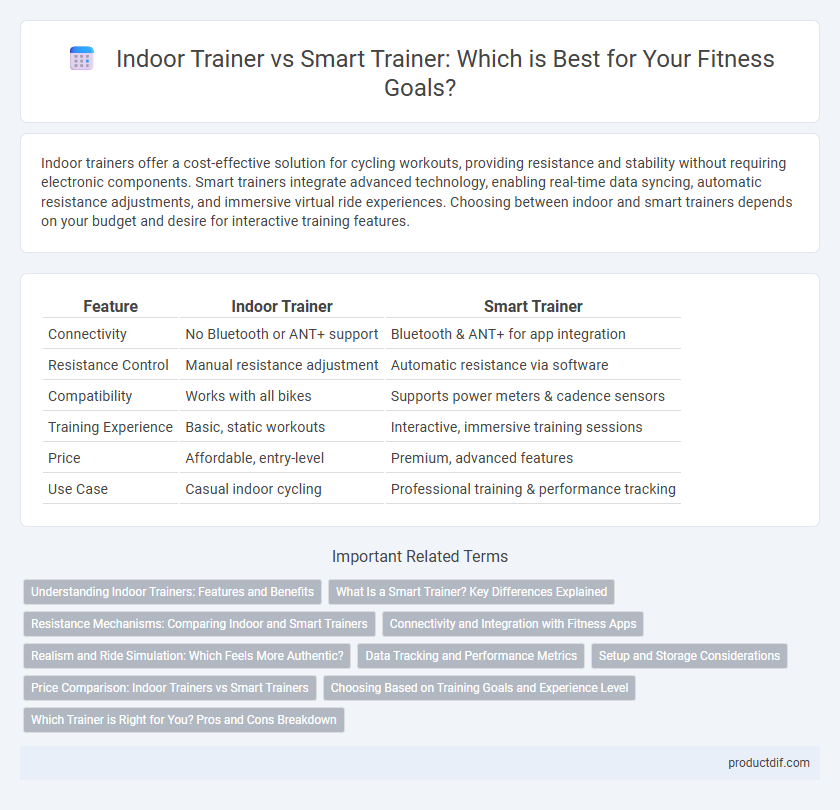Indoor trainers offer a cost-effective solution for cycling workouts, providing resistance and stability without requiring electronic components. Smart trainers integrate advanced technology, enabling real-time data syncing, automatic resistance adjustments, and immersive virtual ride experiences. Choosing between indoor and smart trainers depends on your budget and desire for interactive training features.
Table of Comparison
| Feature | Indoor Trainer | Smart Trainer |
|---|---|---|
| Connectivity | No Bluetooth or ANT+ support | Bluetooth & ANT+ for app integration |
| Resistance Control | Manual resistance adjustment | Automatic resistance via software |
| Compatibility | Works with all bikes | Supports power meters & cadence sensors |
| Training Experience | Basic, static workouts | Interactive, immersive training sessions |
| Price | Affordable, entry-level | Premium, advanced features |
| Use Case | Casual indoor cycling | Professional training & performance tracking |
Understanding Indoor Trainers: Features and Benefits
Indoor trainers offer a range of features designed to simulate real cycling conditions, including resistance control and compatibility with various bike types. These devices provide consistent training environments, enabling athletes to track performance metrics such as power output, cadence, and speed. Enhanced with smart technology, some indoor trainers connect to apps for interactive workouts, making indoor cycling more engaging and effective.
What Is a Smart Trainer? Key Differences Explained
A smart trainer is an advanced indoor cycling device equipped with sensors and connectivity features that simulate real-road conditions by adjusting resistance based on virtual routes or training programs. Unlike standard indoor trainers, smart trainers offer precise power measurement, automatic resistance control, and integration with cycling apps like Zwift or TrainerRoad, enhancing training effectiveness and user experience. Key differences include interactive feedback, performance metrics accuracy, and seamless connectivity for immersive, data-driven workouts.
Resistance Mechanisms: Comparing Indoor and Smart Trainers
Indoor trainers primarily use magnetic or fluid resistance mechanisms that offer consistent but manually adjustable resistance levels, ideal for steady-state workouts. Smart trainers incorporate electromagnetic resistance controlled by software, automatically adjusting resistance based on virtual terrain and workout programs for a more immersive and dynamic cycling experience. These advanced resistance systems in smart trainers provide precise feedback and simulate real-world riding conditions more effectively than traditional indoor trainers.
Connectivity and Integration with Fitness Apps
Smart trainers offer advanced connectivity options such as ANT+, Bluetooth, and Wi-Fi, enabling seamless integration with popular fitness apps like Zwift, TrainerRoad, and Sufferfest. Indoor trainers typically provide basic resistance control but lack comprehensive app compatibility and real-time data transmission. This enhanced connectivity in smart trainers allows precise workout tracking, interactive training experiences, and automated resistance adjustments based on virtual courses.
Realism and Ride Simulation: Which Feels More Authentic?
Indoor trainers offer basic ride simulation by allowing cyclists to pedal stationary, but smart trainers incorporate advanced technology such as power measurement, variable resistance, and connectivity to virtual cycling platforms for a more realistic experience. Smart trainers simulate real-world terrain changes and provide feedback on speed, cadence, and power output, closely mimicking outdoor cycling conditions. This enhanced realism makes smart trainers the preferred choice for serious cyclists seeking authentic ride simulation indoors.
Data Tracking and Performance Metrics
Indoor trainers offer basic data tracking such as speed, distance, and cadence, providing essential performance metrics for casual cyclists. Smart trainers enhance this experience by integrating advanced sensors and connectivity features, delivering real-time power output, torque, and comprehensive workout analytics. These metrics enable precise performance monitoring and tailored training adjustments, optimizing indoor cycling efficiency.
Setup and Storage Considerations
Indoor trainers typically require minimal setup and can be stored easily due to their compact design and lightweight frame. Smart trainers, while offering advanced features like app integration and automatic resistance adjustment, often demand a more involved setup process and may require dedicated space for storage. Considering available space and ease of assembly helps determine the best option for efficient use and convenience.
Price Comparison: Indoor Trainers vs Smart Trainers
Indoor trainers generally offer a more budget-friendly option, with prices ranging from $100 to $400, making them accessible for casual cyclists. Smart trainers, equipped with interactive features and connectivity for apps like Zwift, typically start around $500 and can exceed $1,500, reflecting their advanced technology and performance tracking capabilities. The price difference often correlates with functionality, where smart trainers provide a more immersive and data-driven training experience compared to basic indoor trainers.
Choosing Based on Training Goals and Experience Level
Indoor trainers offer a budget-friendly solution ideal for beginners focusing on basic endurance and consistent indoor workouts, while smart trainers provide advanced metrics and interactive experiences suitable for experienced cyclists aiming to optimize performance and engage in virtual riding platforms. Selecting between an indoor trainer and a smart trainer depends largely on training goals, with smart trainers supporting structured workouts, power data analysis, and connectivity to cycling apps for performance tracking. Experience level also plays a crucial role; novices benefit from the simplicity of indoor trainers, whereas seasoned athletes gain from the comprehensive features and resistance control of smart trainers.
Which Trainer is Right for You? Pros and Cons Breakdown
Indoor trainers offer a cost-effective option for consistent cycling workouts with stable resistance but lack real-time data integration, making them ideal for beginners focused on endurance and basic training. Smart trainers provide advanced features such as interactive resistance control, real-time performance metrics, and compatibility with training apps, catering to serious cyclists seeking immersive, data-driven sessions. Choosing between indoor and smart trainers depends on your budget, training goals, and desire for technology-enhanced cycling experiences.
Indoor Trainer vs Smart Trainer Infographic

 productdif.com
productdif.com